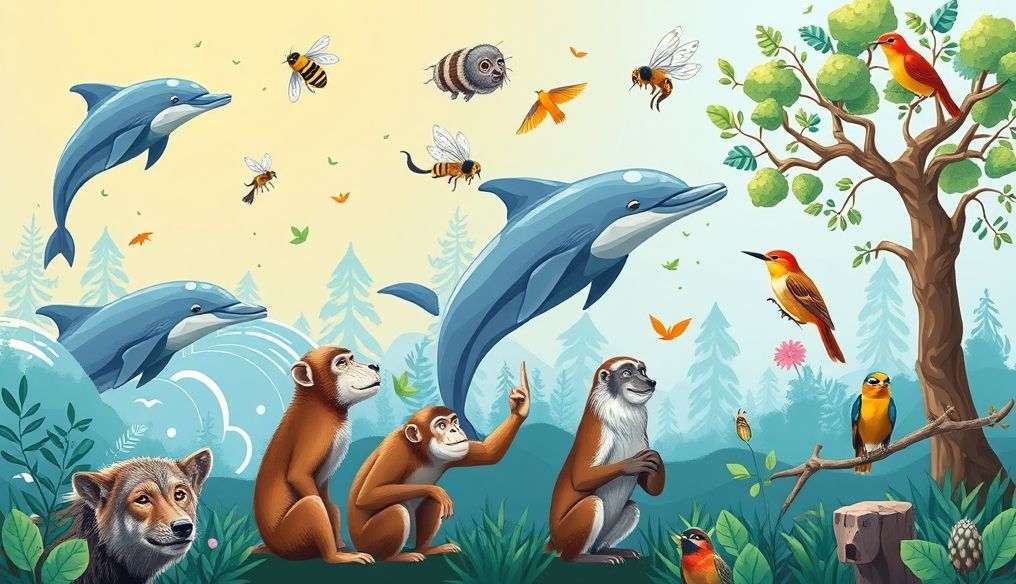Introduction to the World of Animal Communication
Since ancient times, humans have sought to understand the language of animals, the creatures that share our planet. We have long believed that communication is limited to humans, but recent research has revealed an amazing world of signals and symbols that animals use to express their needs and feelings.
Animal communication is not limited to making sounds; it includes a wide range of behaviors, such as body movements, chemical signals, and even touch. These diverse methods allow animals to interact with each other and form complex societies.
What is "Language" in the Animal World?
When we talk about "language" in the context of animals, we don't necessarily mean the same complexity that characterizes human language. Human language is characterized by complex grammatical rules and the ability to express abstract ideas. Animal communication is often more focused on basic needs, such as mating, warning of danger, and defining territory.
However, this does not mean that animal communication is simple or primitive. Some animals, such as dolphins and monkeys, use complex communication systems that include a variety of sounds and signals. Some studies even suggest that these animals are able to learn simple words and use them to communicate with humans.
Diverse Forms of Animal Communication
The forms of animal communication vary greatly, depending on the type of animal and its environment. Here are some examples of these forms:
- Vocal Communication: Includes barking, meowing, chirping, hooting, and other sounds that animals use to express their feelings or to communicate with each other.
- Visual Communication: Includes body movements, gestures, facial expressions, and bright colors that animals use to attract attention or send specific messages.
- Chemical Communication: Includes the use of pheromones, which are chemical substances secreted by animals to influence the behavior of other animals.
- Tactile Communication: Includes hugging, kissing, hitting, and other forms of touch that animals use to strengthen social bonds or express aggression.
Examples of Amazing Animal Languages
There are many amazing examples of animal languages around the world. Here are some examples:
- Bees: Bees use a complex dance called the "waggle dance" to tell the rest of the hive the location of food sources.
- Dolphins: Dolphins use a variety of clicks and whistles to communicate with each other, and each dolphin may have a unique "name" that distinguishes it from others.
- Monkeys: Monkeys use a variety of sounds and gestures to communicate with each other, and they can learn simple words from humans.
- Birds: Birds use complex songs to attract mates and express ownership of territory.
- Wolves: Wolves use howling to communicate with other packs and locate them.
How Do We Understand Animal Language?
Understanding animal language is not easy, but it is possible. It requires years of study and observation, as well as the use of advanced technology, such as audio recorders and surveillance cameras.
Biologists study the behavior of animals in their natural environments and record the sounds and signals they make. They then analyze this data to determine their potential meanings. In addition, some scientists train animals to use sign language or symbols to communicate with humans.
The Importance of Understanding Animal Language
Understanding animal language has many benefits. It can help us better understand animal behavior, protect endangered species, and improve our relationship with pets.
For example, if we understand how wild animals communicate, we can take steps to protect their natural habitats and prevent conflicts between humans and animals. And if we understand how pets communicate, we can better meet their needs and form stronger relationships with them.
Challenges in Studying Animal Language
Studying animal language faces many challenges. First, it is difficult to decipher the sounds and signals that animals make. Second, it is difficult to be sure that we understand the true meaning of what animals are saying. Third, it is difficult to study animals in their natural environments without affecting their behavior.
However, despite these challenges, scientists are making great progress in understanding animal language. As technology continues to develop, we are likely to discover more about the world of animal communication in the future.
The Future of Animal Communication Studies
The future of animal communication studies looks promising. With the development of technology, we have new tools to study animal behavior and understand their language. For example, we can now use artificial intelligence to analyze vast amounts of audio and visual data and identify patterns that we may not be able to see ourselves.
In addition, there is growing public interest in understanding animal language. This interest could lead to increased funding for research and increased awareness of the importance of protecting animals and their natural environments.
In conclusion, the world of animal communication is an amazing and complex world. Although we may not fully understand animal language, we are making great strides in this area. Understanding animal language can help us better understand their behavior, protect endangered species, and improve our relationship with pets.




